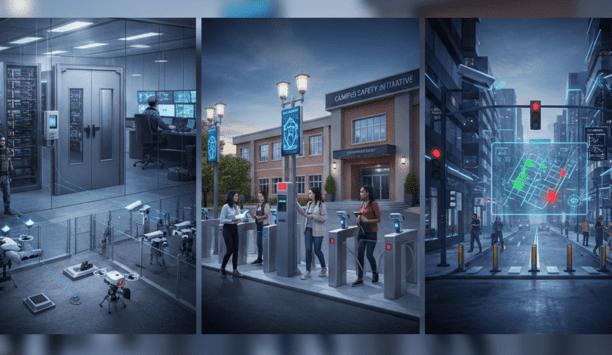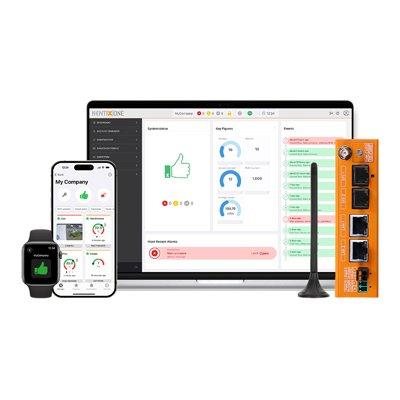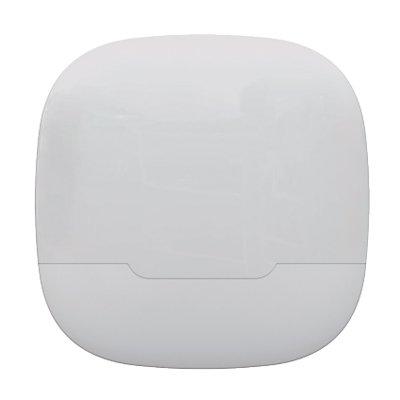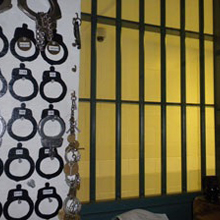 |
| The new IP-based systems use the Ocularis software system with more than 4,600 Panasonic network cameras |
In today’s economy, it can be difficult for correctional facilities to obtain the funding needed to upgrade their security technologies. However, a series of high visibility incidents in Texas in 2008 cast a bright light on the benefits of video surveillance and the critical need to maintain high-performing systems. Now the Texas Department of Criminal Justice (TDCJ) has made a true commitment to invest in state-of-the-art IP-based video surveillance technology to enhance security within its prisons.
In 2008, a death row prisoner managed to obtain a cell phone, an item strictly forbidden to inmates. He used the phone to make threatening phone calls to Texas State Senator John Whitmire, chair of the Texas Senate committee on Criminal Justice, as well as to a reporter for the Austin American-Statesman, a daily newspaper in Austin, Texas. After working with officials to catch the prisoner utilising the phone, Senator Whitmire helped facilitate availability of state funding to install security systems to help prisons deal more effectively with the issue of contraband.
There are 111 prisons across Texas housing about 150,000 offenders statewide. While many facilities have camera systems, more advanced new video surveillance systems have been installed in four prisons so far – the Allan B. Polunsky Unit in Livingston, Texas; the Mark W. Stiles Unit in Beaumont, Texas; the Darrington Unit in Rosharon, Texas, and the McConnell Unit in Beeville, Texas. New systems are also in the process of being installed at the Connally Unit in Kenedy, Texas, and the Coffield Unit in Tennessee Colony, Texas, the state's largest prison encompassing 20,000 acres and housing more than 4,000 offenders. Additional new video surveillance systems may be rolled out in the next five to ten years in other Texas prisons, contingent upon funding. Video systems are also being planned for the 20 state jails throughout Texas.
"Video surveillance is not a new concept in the correctional environment, but technological advances offer opportunities that cannot be ignored to further enhance security, increase staff and offender safety and combat contraband,” said Brad Livingston, TDCJ Executive Director. “In my opinion, the comprehensive video surveillance system in use at several TDCJ facilities represents an effective application of the latest technologies and is making a significant contribution to security and safety."
“Upgrades will be simple and an absolute given in the future course of high security vigilance.” |
Sigma Surveillance (STS), Plano, Texas, is designing and installing the new systems from end to end and has also installed a full network infrastructure as the prisons are not wired for any networked technology. Fibre-optic cable was installed to every building on the installations so far, as well as to every perimeter post and the guard towers.
The new IP-based systems use the Ocularis software system by OnSSI, together with more than 4,600 Panasonic network cameras system wide to capture detailed video of everything that happens within the prison walls, making it available to wardens and other prison staff. Wardens are now accustomed to using the system as part of their everyday routine and have captured video of assaults on staff and offenders as well as other incidents. The systems also allow them to give accolades to prison staff members who are captured on video making smart decisions.
The Panasonic cameras have been used to investigate contraband such as drugs, cell phones and money drops inside the prison. The system catches the drop and provides evidence to corroborate the incident. They have also been used to prove cases in criminal and administrative proceedings.
Wardens value the ease of use of the Ocularis system. Simplified interfaces do not take a lot of space on the monitor screen, and the staff appreciates the search features, especially the motion searches. On playback, prison staff can use the “little blue box,” a feature that enables them to designate a specific area on the screen and identify on playback when there is motion within that area. The Panasonic cameras deployed consist mostly of vandal-resistant fixed domes. The most recent installation at the McConnell Unit uses all-HD (high-definition) cameras, as will future installations. High quality video available in virtually any lighting condition delivers clear and continuous coverage of activities within the prison system.
Systems installed in first three prisons
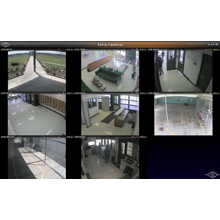 |
| The Panasonic cameras have been used to investigate contraband such as drugs, cell phones and money drops |
Allan B. Polunsky Unit is a 472-acre maximum-security prison that houses about 2,900 offenders at a range of custody levels including maximum security and Death Row. Originally designed to house 2,250 offenders, the Polunsky unit has been expanded with the addition of dormitory buildings. The prison encompasses a total of 19 buildings, including a medical and education facility with a standard library and a legal library, a supply warehouse, four general population chow halls, one officers' dining room, a laundry room, an administration building, a maintenance building, a vocational facility, and two gyms that are also used as chapels. The facility also includes a tree farm and a dog kennel. Security for the Polunsky Unit includes video coverage of every building and every walkway as well as the perimeter. Aiphone video intercoms are installed on the premises to provide efficient and easy communications with the correctional staff.
Richard Alford, Senior Warden at the Polunsky unit, has used the video system to monitor and critique his staff's response to unit emergencies. “You get a minute-to-minute response to suicide attempts and things of that nature,” he said. Such incidents require an administrative review, and the video provides a valuable tool. Warden Alford also says the system helps to quickly dismiss false offender complaints without merit– the video can easily verify if complaints are unfounded.
Another prison whose video system has been upgraded is the Mark W. Stiles Unit, which was also originally designed to accommodate 2,250 offenders and also now has additional dorms to serve a current occupancy around 2,900. Stiles has about 20 buildings, including a separate chapel. Mike Roesler is the Senior Warden at Stiles Unit.
The Darrington Unit is a very old high-security prison, built in 1930. It is made up of a single building (in contrast to the multiple buildings and campus setting of the other units). Darrington houses about 2,000 offenders and uses about 490 cameras.
The advanced video system provides an advantage for prison wardens to help reduce incidents of contraband, gang activity and other challenges unique to a prison environment, while increasing productivity and safety. “When you have a camera and have an incident, you see what's happening,” said former Senior Warden Brenda Chaney, Darrington Unit, who recently retired. “Without the video you have to do more questioning and investigative measures to find out what occurred. There are times when you can't get to the bottom of what occurred (without a camera). If there's a fight, who was involved? When security comes, they spread out, but with a camera you would see who's involved. With a camera, you've got them.”
The fourth unit, with installation now complete, is the McConnell Unit, which is similar in design to Polunsky, Stiles and to the Connally unit currently being installed.
In each installation, the fibre infrastructure includes a 10-gig backbone and 1-gig horizontal to smaller network rooms and user workstations. Each cable pull has 12 fiber strands, which allows plenty of dark fibre to add future bandwidth. “We were cognizant of the need to facilitate the future expansion in all areas of the units, so as to avoid costly expansions in the future in order to continue to take advantage of the latest security trends,” said Jose Garza, CCNP, Technical Project Manager of STS. “Upgrades will be simple and an absolute given in the future course of high security vigilance.”
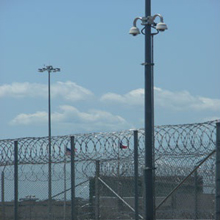 |
| Security for the Polunsky Unit includes video coverage of every building and every walkway as well as the perimeter |
HP ProLiant DL320 servers are used to run the Ocularis 2.0 software, and ProLiant DL380 servers are used for recording using OnSSI's IS software and for initial temporary archives. Each NetDVR server runs 50-plus cameras, which takes a lot of processing power, so Ocularis, the “brains” of the system was assigned its own server. The storage array includes network-attached storage (NAS) [HPX160, two at each unit] and direct-attached storage [HP StorageWorks D2600 DAS Hard Drive Array and HP MSA60]. The servers and workstations are HP, and HP switches are used throughout the network rooms. Each unit has 16 servers used as network video recorders (NVRs) and one Ocularis server. The system can record continuously for 20 days, 24 hours, seven days a week, full streaming at all times with no motion-based recording in order to document when things don’t happen as well as when they do. This is a unique prison need to immediately disprove a falsely filed complaint against an officer and reduce the agency's cost of lengthy investigations. PowerDsine mid-span injectors are used to provide Power over Ethernet, a less expensive option than PoE switches.
STS made an extra effort to distribute video archiving across multiple servers and NAS attachments for cameras in each single pod. Cameras in the same area are archived to different storage areas to ensure continued redundant coverage. The approach involved extra planning up front and attention to mitigating a possible risk.
In a challenging environment like a prison unit, TDCJ officials realise that no one tool is the solution. “The video surveillance system is another means at our disposal. We’ll continue to look to technology, combined with other security measures, as a way to enhance the safety and security of institutions across the state of Texas,” said TDCJ Executive Director Brad Livingston.
How staff use the systems
In administration at each prison, there is a senior warden and two assistant wardens who have full rights to view the system in their offices. Two majors (three at Stiles) have full rights as well on HP workstations. The senior warden has a 42-inch screen, and everyone else has 19-inch monitors on their desks. A 42-inch monitor is located in an administrative conference room; if an event occurs in the unit, the conference room becomes a command center with more space for team members than a single office.
Video monitors are also located at various “pickets,” which are enclosed locations protected from intrusion, where operators can control doors and have keys to certain areas. The ‘line control’ pickets have a 42-inch monitor and have access to everything on the system except the ability to export video. In the death row building at the Polunsky Unit, a control picket has four 20-inch monitors to push video, and in one of the pods, a 20-inch monitor has rights to view in cell cameras. Inside dormitories, each picket has four 20-inch monitors and has the master stations for the Aiphone video intercom. Ocularis provides a push event when an intercom button is pressed.
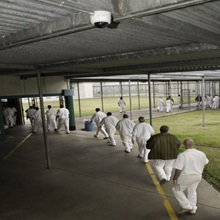 |
| Warden Alford uses the system not just as a reactionary tool but as a proactive tool, monitoring traffic flow |
Each workstation is located within a lock box for security purposes. Operators can only access the keyboard, mouse and monitor. There is also no access to any of the network rooms, and racks are secured with locks.
Warden Alford uses the system not just as a reactionary tool but as a proactive tool, monitoring traffic flow, counting and search procedures. He sees a continuing and increasing role for video in training his staff. “If I see someone violating a policy, I can download the video and take it to shift turnout and tell them 'this is not what we need to do.'” Shift turnout is a 30-minute meeting before a new shift comes to work when various issues and training are discussed.
Training uses can also extend to the 40 hours of in-service training required each year. Important points can be illustrated using video of actual events. “I can go back and show them, this is reality, and this is the event in real-time,” said Warden Alford. “You see how if this officer was over here, this wouldn't have happened.” He compares the approach to a football coach meeting after a game to make adjustments to offense and defense. “It can be a positive force in learning. They are more critical of their own performance than I am.”
“Holding staff accountable can sometimes be difficult,” added Warden Alford. “On a unit this size, you can't walk the whole unit. If I don't walk in a building in a day, I can still look at the video to see things I might not have seen.”
Using video surveillance a 'No Brainer'
The system's ease of use is critical; corrections officers may not necessarily be IT experts, but Ocularis is highly intuitive. The use of maps in Ocularis greatly simplifies interface with the video system. Many areas in a prison look the same, so it is not easy to visualise a camera's location. Operators can click into each building, and all the cameras will come up, instead of one camera at a time. It's a useful tool that makes it easy for staff to locate the cameras they are looking for.
“TDCJ's use of best-of-breed technologies, the support of top industry partners and collaboration with TDCJ personnel have created an impressive and invaluable result” |
The system at Polunsky unit came online in stages over almost a year, and officers began using the system as it became live. Tim Simmons was senior warden at Polunsky Unit when the system was installed, but retired after 30 years and is now the Public Sector Vice President at STS, continuing to work on future installations. “The vendor provided training on the system, but because we started using it as it came up, we basically didn't need any training,” said Simmons. “The software is intuitive and extremely user-friendly.”
TDCJ has also purchased five-year service agreements, including Software Upgrade Protection plans from OnSSI, which ensure Texas prisons will continue to get the advantages of the latest software versions as they are released.
Despite budget constraints, the Texas Legislature has continued to invest in public safety. “We’re grateful to Governor Rick Perry and the Legislature for providing funding to enhance the security of our facilities,” said TDCJ Executive Director Brad Livingston. “They made this a priority, and we’re committed to putting those limited resources to good use.”
“TDCJ's use of best-of-breed technologies, the support of top industry partners and collaboration with TDCJ personnel have created an impressive and invaluable result,” said Bobby Khullar, President/CEO of STS.
Ultimately, the system provides prison staff unprecedented access to the units. A warden using the system can see their units like never before, which has dramatically increased control. Texas prisons have had numerous visitors from other states who have been impressed by the system's functionality; one prominent prison official from another state simply said “I want one.”
Understand how converged physical and cybersecurity systems can scale protection.






